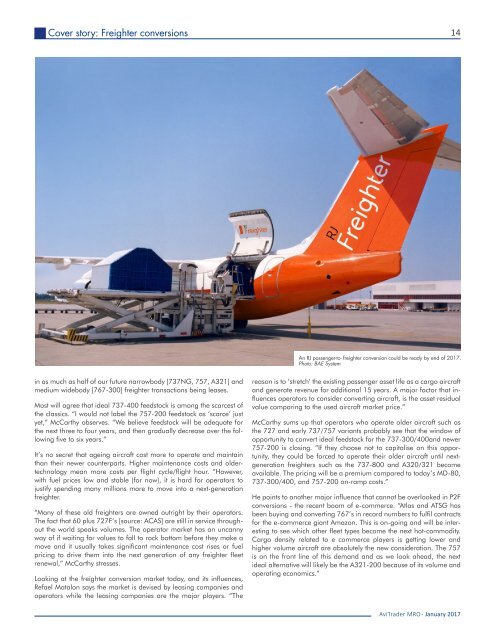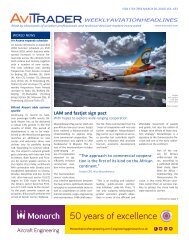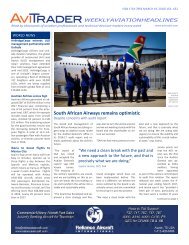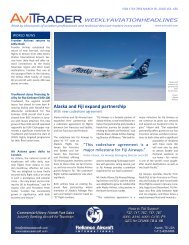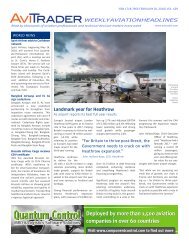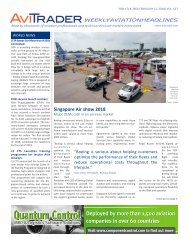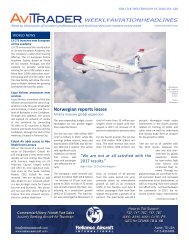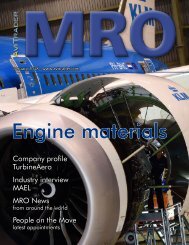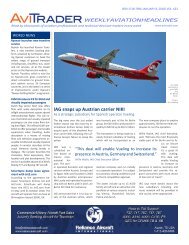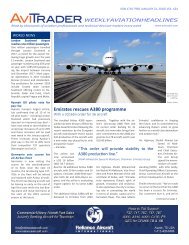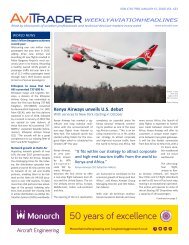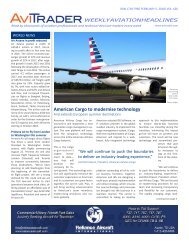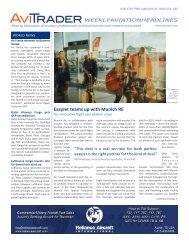AviTrader MRO Magazine 2017-01
AviTrader MRO Magazine 2017-01
AviTrader MRO Magazine 2017-01
You also want an ePaper? Increase the reach of your titles
YUMPU automatically turns print PDFs into web optimized ePapers that Google loves.
Cover story: Freighter conversions<br />
14<br />
An RJ passenger-to- freighter conversion could be ready by end of <strong>2<strong>01</strong>7</strong>.<br />
Photo: BAE System<br />
in as much as half of our future narrowbody [737NG, 757, A321] and<br />
medium widebody [767-300] freighter transactions being leases.<br />
Most will agree that ideal 737-400 feedstock is among the scarcest of<br />
the classics. “I would not label the 757-200 feedstock as ‘scarce’ just<br />
yet,” McCarthy observes. “We believe feedstock will be adequate for<br />
the next three to four years, and then gradually decrease over the following<br />
five to six years.”<br />
It’s no secret that ageing aircraft cost more to operate and maintain<br />
than their newer counterparts. Higher maintenance costs and oldertechnology<br />
mean more costs per flight cycle/flight hour. “However,<br />
with fuel prices low and stable (for now), it is hard for operators to<br />
justify spending many millions more to move into a next-generation<br />
freighter.<br />
“Many of these old freighters are owned outright by their operators.<br />
The fact that 60 plus 727F’s [source: ACAS] are still in service throughout<br />
the world speaks volumes. The operator market has an uncanny<br />
way of if waiting for values to fall to rock bottom before they make a<br />
move and it usually takes significant maintenance cost rises or fuel<br />
pricing to drive them into the next generation of any freighter fleet<br />
renewal,” McCarthy stresses.<br />
Looking at the freighter conversion market today, and its influences,<br />
Refael Matalon says the market is devised by leasing companies and<br />
operators while the leasing companies are the major players. “The<br />
reason is to ‘stretch’ the existing passenger asset life as a cargo aircraft<br />
and generate revenue for additional 15 years. A major factor that influences<br />
operators to consider converting aircraft, is the asset residual<br />
value comparing to the used aircraft market price.”<br />
McCarthy sums up that operators who operate older aircraft such as<br />
the 727 and early 737/757 variants probably see that the window of<br />
opportunity to convert ideal feedstock for the 737-300/400and newer<br />
757-200 is closing. “If they choose not to capitalise on this opportunity,<br />
they could be forced to operate their older aircraft until nextgeneration<br />
freighters such as the 737-800 and A320/321 become<br />
available. The pricing will be a premium compared to today’s MD-80,<br />
737-300/400, and 757-200 on-ramp costs.”<br />
He points to another major influence that cannot be overlooked in P2F<br />
conversions - the recent boom of e-commerce. “Atlas and ATSG has<br />
been buying and converting 767’s in record numbers to fulfil contracts<br />
for the e-commerce giant Amazon. This is on-going and will be interesting<br />
to see which other fleet types become the next hot-commodity.<br />
Cargo density related to e commerce players is getting lower and<br />
higher volume aircraft are absolutely the new consideration. The 757<br />
is on the front line of this demand and as we look ahead, the next<br />
ideal alternative will likely be the A321-200 because of its volume and<br />
operating economics.”<br />
<strong>AviTrader</strong> <strong>MRO</strong> - January <strong>2<strong>01</strong>7</strong>


